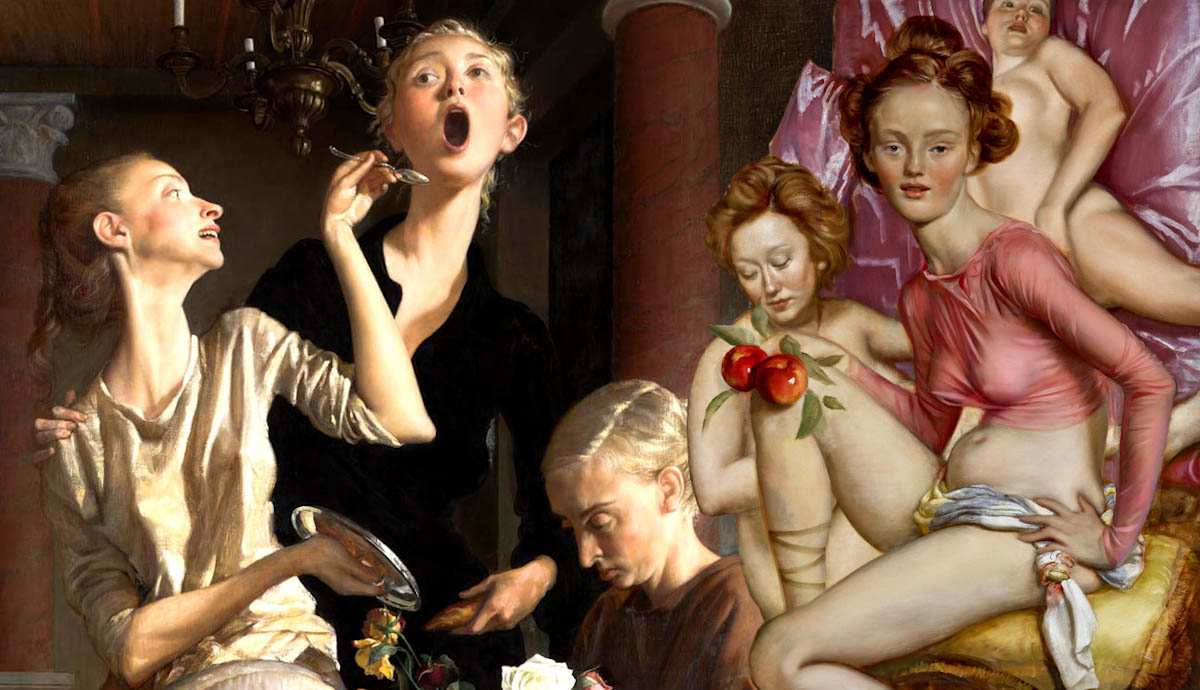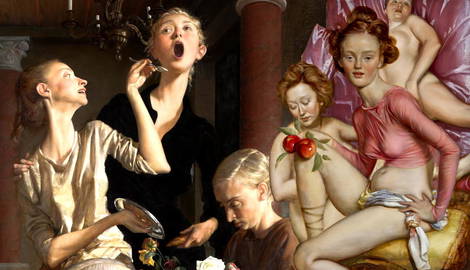
John Currin is one of today’s most celebrated contemporary American painters. He is known for his use of traditional oil painting techniques, which give his work an aesthetic resemblance to European painting from the Renaissance and Baroque eras. Currin combines this studious and stubbornly traditional approach to painting with crass subject matter, challenging conventional artistic taste. In doing so, his work is both humorously provocative and surprisingly genuine.
The Delightful Repulsion of John Currin’s Paintings

When confronting one of John Currin’s paintings, one might feel both allured and repelled. Currin’s work balances the frivolities and crassness of American popular culture with the indisputable gravity of high art. In technique and aesthetic, his paintings recall those of the late European Renaissance. Currin’s wonderful craft, that is, the literal, physical beauty of his paintings’ surfaces, draws the viewer in.
Though his technique harkens back to the old masters of European art, John Currin is an undisputed American painter. The late Renaissance aesthetic of his work is a self-consciously commodified version, informed by the gaudiness of American culture. There is a glee in Currin’s keen, incisive awareness of distinctly American depravity. The artist seems to lambast, in equal measure, himself, his audience, and the broader culture which has spawned all of it. The intensity of these images results in discomfort, embattled with attraction. His paintings are lavish, decadent, and hedonistic. At the same time, the works give feelings of insecurity, anxiety, and repentance because Currin’s art is painfully self-aware.
The Embarrassment of Painting

Many of John Currin’s works convey embarrassment. This feeling of embarrassment is multi-faceted. There is both an obvious embarrassment to the depictions of Currin’s figures, on account of their ludicrous proportions and caricature-like visages, and the narratives of desire he typically portrays, characterized by comic over-indulgence.
John Currin’s pornography-based paintings are the clearest example of his embracing embarrassment. The lack of inhibition inherent to the imagery, in all its crassness, is exquisitely, carefully rendered, demonstrating an admirable focus and restraint. Observe the frantic, erotic action of Rotterdam, emblematic of the tone and conventions of commercial, filmed pornography. The recreation of such a scene as a painting, aspiring to the level of craft and beauty established in the Renaissance is immediately jarring. The overall effect of these two clashing instincts is both beautiful and perverse, producing in the audience the same embarrassed pleasure Currin has taken part in by creating the painting.

In an interview with the New York Times, Currin speculated on the genesis of embarrassment in his work: “For whatever reason, I am attracted to embarrassing situations in painting. I think I seek it out. But I think I also fear it, so I’m not sure. I would say that I’m embarrassed by my body. As Rumsfeld would say, “You go to war with the army you have,” or whatever. And the army I have is plagued by embarrassment and insecurity.” (John Currin, 2019)
Though Currin focuses here on the narrative and imagistic content of his work, this sense of embarrassment extends to the form of his paintings. An aspect of embarrassment in John Currin’s work is the knowing indulgence in traditional oil painting techniques more than a century after such painting went out of style. After his initial attempt to keep up with the developments of painting through the end of the 20th century, Currin found himself pulled backward by the allure of the stodgy old masters. Early in his artistic studies, Currin was explicitly inspired by other American painters, gravitating towards Abstract Expressionism.
Speaking with Calvin Tomkins of The New Yorker, Currin described the paintings he made during art school as “fake De Koonings.” It was not until years after he graduated from the MFA program at Yale that Currin began to paint in the figurative style for which he is known today. At first, this sort of painting felt embarrassing on account of its kitschiness in the context of modern and contemporary art.

The consistent depictions of sex, eating, and drinking in John Currin’s work draw an equivalency between consumptive, carnal, potentially shameful pleasure and his inclination towards an artistic style which has been largely surrendered to kitsch and generally classified as a contemporary art faux-pas. The three women in Stamford after Brunch, huddled with their cigars and martinis, exhibit delight at their surrender to decadence, just as Currin gives into the luscious oil paint, glazed and luminous, glowing with a sincerity he cannot help. A great boon to the work is Currin’s willingness to be sincere, knowing full well the sacrifice of conventional, contemporary artistic taste. The kitsch leanings of Currin’s work are neither naïve nor mocking, rather he is perfectly aware of the artistic consequences of the aesthetics and techniques which he nonetheless pursues without irony.
During his time in an academic setting, John Currin fell in line with the more acceptable, apparently progressive artistic approach of abstraction. With time, however, he has come to own the old-master-ish style of figure painting with all of its present kitsch associations and tinged by his status as a contemporary American painter. Fully aware of the context, he nonetheless embraces the aesthetics of embarrassment through his conservative painting technique and constant reckoning with the crass and shameful nature of desire in the current moment.
The American Painter’s Humor

Allowing John Currin’s work to function under the pressure of self-consciousness is his humor. Though it undoubtedly requires a great deal of genuine care to paint in the manner Currin does, he diffuses the seriousness of that pursuit with narrative and stylistic decisions. It is the absurdity of a scene like Newspaper Couple which stops the romanticism of Currin’s technique from becoming drearily affected or cloying.
Furthermore, humor appropriately grounds the potentially tedious cultural commentary. The tone of the paintings helps this messaging appear not contemptuous or important, but cleverly provocative. Regarding the levity of his paintings, the artist has stated: “I realized I could be different from everyone else just by being cheerful in my work,” he said. “In art school, I wanted to be intense, like Francis Bacon, but I’m not—I’m better when I’m jokey and cheerful.” (John Currin, 2008) The humorous tone of Currin’s work is uncommon in fine art. The effect is doubly surprising when paired with his studious and immaculate technique, which reveals an entirely serious appreciation for traditional oil painting.

John Currin’s choice to bring jokiness to his paintings is most clearly observed in his intensification of the Mannerist style pioneered in the 16th century by painters like Tintoretto, Pontormo, and El Greco. Just as in Mannerism, Currin’s figures are exaggerated, though he goes beyond the idealized elegance and beauty exhibited in Mannerist paintings to something verging on the cartoonish and occasionally crossing that threshold. The strength of this stylization results from Currin’s affected representation of a perspective already warped by American consumerist culture. His vision is doubly distorted, and knowingly so, by the aesthetic trends of 16th-century European art reinterpreted and exaggerated by an American painter to accommodate his own cultural peculiarities.

The results are plain in the distension of John Currin’s subjects, most obviously, the female figures and their typically enlarged breasts, long necks, disproportionate heads, and tapering limbs. As well, there are less abrasive effects; take, for example, The Penitent, where the face of the sitter is slightly stretched and flattened, emphasizing the flatness of the painting and the conventions of painted space. Another painting, Nude in a Convex Mirror, demonstrates in both its title and image, the overt distortion and reflection which define Currin’s figurative style.
John Currin’s Affectation and Imagecraft

John Currin gets his imagery from a variety of sources and each painting is a composite of numerous references. He has variously used advertisements and commercial photography, pornography, and live models. The effect of this is the feeling of a deliberately synthetic reality in the paintings. It never quite feels that any of the figures represent a specific person. Rather they are characters, scenes, and aspects of Currin: animated coalitions of the various cultural ephemera he sorts through. The only exception might be his wife, Rachel Feinstein, whose face can be recognized in a huge number of the paintings. Even then, she appears as something other than just herself; Currin consciously recognizes the interpreted version of her as a separate entity distorted and filtered through other media, images, ideas.
Beyond the obvious stylistic tendencies of John Currin’s work, the compositions are already unreal and awkward: overly posed and relying on the particular wonkiness of painted space to make the trick of compositing function. For instance, in Currin’s Thanksgiving, all three figures are modeled after Currin’s wife. This replication gives the painting a subtle sense of unreality, further emphasized by other elements of the picture, such as the plated raw turkey. As well, this scene of a Thanksgiving dinner rendered in a style typical of the late Renaissance underscores Currin’s status as an American painter in contrast to the European tradition of oil painting which he invokes, further displacing him and his work.
Thus, Currin’s involvement not just as the recorder of the scene, but as the one shaping it, and inventing it is emphasized. The pictures are consciously distorted introspections. Narrative and image become blunt and stilted, like a joke the artist cannot quite keep to himself.










